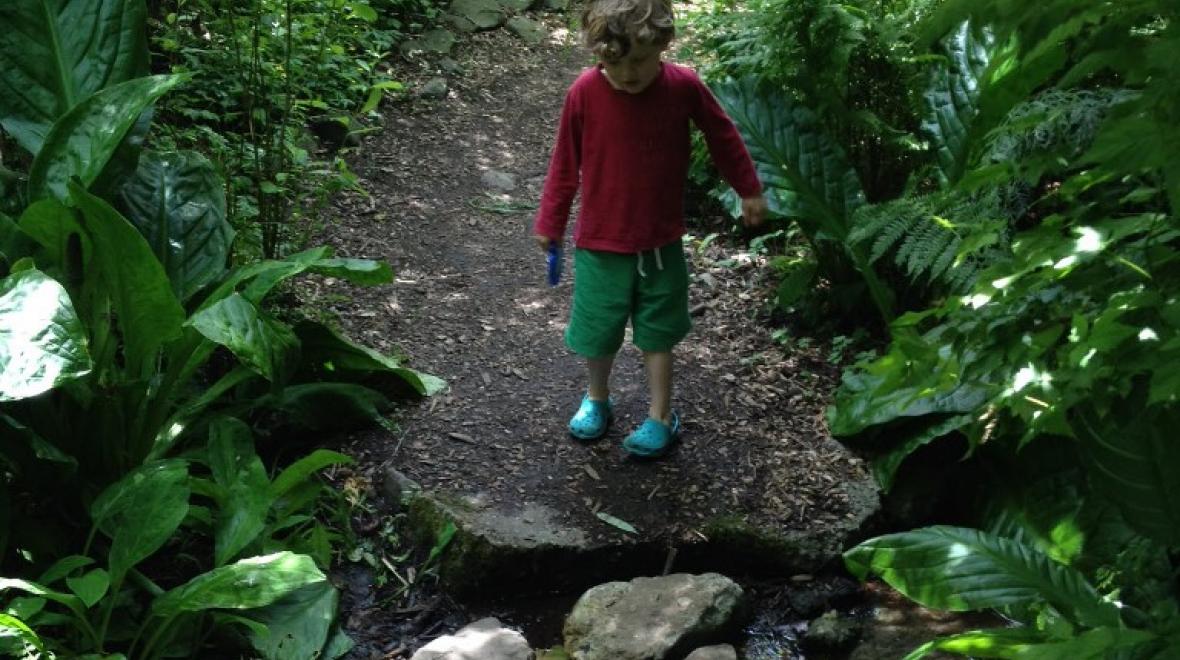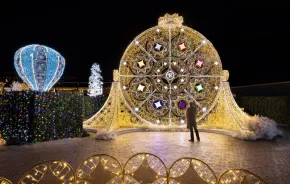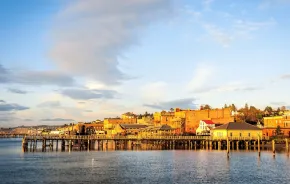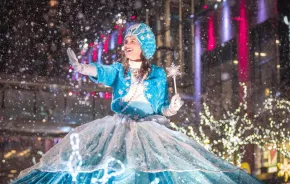
Photo:
Northgate Natural Area. Photo credit: Bryony Angell
“Mom, I wanna see that secret trail!” says my son, pointing to an overgrown path leading farther into the park we are exploring. All around us are the twitters of chestnut-backed chickadees calling from the treetops above our heads. The appeal of both a “secret, off-the-beaten-track” path within the city and the chance of seeing or hearing urban wildlife is an irresistible draw to our family.
We’ve been exploring the tucked-away wild areas around Lake Washington over the past two years, and have discovered some special places that are not only fun to explore but also home to many different types of wildlife.
These urban hikes are part of official city open space but are not as well-known as our larger parks. Each offers different ecosystems to explore, and many are maintained by dedicated neighbors in addition to the municipality it occupies. Most are short hikes ideal for toddlers and preschoolers, although older children will love them as well.
Editor's note: Find the first “secret urban hikes” article here.
 Northcrest Park, Shoreline
Northcrest Park, Shoreline
Talk about hidden! This wooded park bisects a quarter-mile-long suburban block in south Shoreline’s Ridgecrest neighborhood and offers a complete escape into the woods. Having grown up in nearby Lake Forest Park, I thought I knew all the public open space in this area. I only recently discovered Northcrest Park by perusing a city map for greenbelts where I might next explore.
This small, quiet park is perfect for a toddler or young preschooler just learning to hike. The trails are flat and the terrain is open and full of light in spite of being wooded. The north end of the park hosts a play structure and benches, and you'll find a grassy bluff for picnicking on a sunny day. On the day of our visit, my 4-year old son was thrilled with running down every salal-lined side path on his pint-sized adventure. He covered every inch of this modest hike, an important milestone for giving him confidence for longer walks in the future.
 Finding it: 827 N.E. 170th St., Shoreline. There is also an entrance behind the church on the corner of N.E. 165th and 8th Ave N.E. You can park on the street.
Finding it: 827 N.E. 170th St., Shoreline. There is also an entrance behind the church on the corner of N.E. 165th and 8th Ave N.E. You can park on the street.
Wildlife you might see: Black-capped and chestnut-backed chickadee, northern flicker, junco, Bewick's wren, downy woodpecker.
Length of trail: .5-mile round trip
Tips: Wear shoes for the weather as the trails can be muddy. Neighbors bring their dogs here off-leash, so be mindful of meeting a friendly canine. No restroom or running water. Stroller friendly.
 Beaver Pond natural area on Thornton Creek, north Seattle
Beaver Pond natural area on Thornton Creek, north Seattle
Nestled behind office and apartment buildings off of Northgate’s busy Fifth Ave. N.E., you'll find this enchanting natural area close to Northgate Park. Three city blocks contain riparian woods with shimmering leaves overhead, birdsong all around and if you’re lucky, a sighting of one of the resident beavers.
The day of our visit one afternoon, we meandered along the trails of the day-lighted Thornton Creek and plucked salmonberries off trailside bushes. The soft mulched trail wanders in a mostly flat loop through different levels of the forest, crossing the creek several times (kids will enjoy the wooden bridges and the rock-hop across a smaller tributary). Our turnaround point was N.E. 103rd, where we took a peek at the P-Patch garden across the street and then continued back the way we came.
An added treat was a visit to the beaver pond close by, across Eighth Ave. N.E. at N.E. 105th. Resident beaver have successfully dammed the creek, creating the pond that's barely contained by the surrounding neighborhood. Evidence of beaver is everywhere you look, from the gnawed tree trunks and spear-like sapling deadheads (watch out underfoot!), to the beaver lodge itself. You can safely watch for beaver along the south edge of the pond at N.E. 106th St. (Eighth Ave. N.E. is a busy street despite being narrow). Dusk is the best time to see them.
Finding it: There is no exact address, but the area is accessible from N.E. 105th and N.E. 103rd between Eighth Ave. N.E. and Fifth Ave. N.E. in Seattle. The Beaver Pond natural area is at the corner of N.E. 105th and Eighth Ave. N.E. Park on the street.
What you might see: Beaver, wood duck, gadwall duck, mallard duck, downy woodpecker, northern flicker, all kinds of songbirds in the woods.
Length of trail: About six city blocks round trip.
Tips: Keep hands and feet out of the creek, as recent reports indicate high levels of pollution. No bathrooms, running water or garbage cans. It's stroller friendly.
 North Seattle College greenbelt trails, north Seattle
North Seattle College greenbelt trails, north Seattle
On a late winter evening as we left preschool on the campus of North Seattle College, we heard the steady chorus of resident frogs above the roar of traffic from nearby I-5 — a magical noise in such an urban setting.
From the parking lot at the north end of the college, you can hear this chorus starting in as early as January. Any time of year, though, is worth a visit to this hidden pocket of wetlands next to the interstate. In April, we explored the open meadow next to the shallow seasonal pond, where a pair of northern shoveler ducks swam. Futher into the park several wooded trails lead down gentle slopes, over a bridge, and past thickets begging for trail-blazing by young kids. The greenbelt is welcoming for a walk or picnic, but also left “wild” in certain areas where students are studying habitat.
Finding it: 9600 College Way N., Seattle. Enter North Seattle College at N. 100th Street and College Way N. and find parking in the lot (you may have to pay). Or park on College Way North. The marsh and pond are directly to the north of the campus parking lot, with trailheads off the lot.
Wildlife you might see: Pacific tree frogs, long-toed salamander, red-winged blackbird and other bird species.
Length of trail: About six city blocks round trip
Tips: Frogs are very fragile creatures. Do not attempt to touch or disturb them in any way. Stay on trails and leave pets at home. Stroller friendly. No bathrooms, running water or garbage cans; however, the college is close by.
 St. Mark's Greenbelt, Capitol Hill/Eastlake, Seattle
St. Mark's Greenbelt, Capitol Hill/Eastlake, Seattle
If your family is up for some hill-climbing into a ravine, this urban trail offers a hike-like atmosphere right off a frontage road of I-5. Since the trail is steep in places and a bit of a scramble, this walk is better for kids preschool-age and up rather than toddlers (it's definitely not stroller friendly).
On our spring visit, the trees were just beginning to leaf and obscure the view toward Lake Union as we ascended the trail beside the historic Egan House along Lakeview Boulevard. The Egan house sits isolated from other structures below the green bluff of Saint Mark’s Cathedral, surrounded by maples and ivy, and offers a modernist twist to an otherwise nature-oriented outing.
As my son and I made our way up the trail, evidence of reforestation and invasive plant abatement became obvious, and the trail itself became less primitive. We met a young volunteer on the trail, part of the neighborhood effort to restore native and maintain the area.
 A wooden bridge crosses a no-name creek through the ravine. Above, mansions loom at the ravine’s edge. Further up the trail are stone steps leading to the cathedral parking lot. You can either turn around and retrace your steps back down, or take the Blaine Street stairs down. To find it, walk a few blocks north on 10th Avenue E., then take a left on Blaine Street to descend on the Blaine Street stairs, which border the Streissguth Gardens.
A wooden bridge crosses a no-name creek through the ravine. Above, mansions loom at the ravine’s edge. Further up the trail are stone steps leading to the cathedral parking lot. You can either turn around and retrace your steps back down, or take the Blaine Street stairs down. To find it, walk a few blocks north on 10th Avenue E., then take a left on Blaine Street to descend on the Blaine Street stairs, which border the Streissguth Gardens.
Finding it: The park trailhead is located at 1500 Lakeview Blvd. E., Seattle. You can park at the Egan House parking lot, or along the boulevard. You can also park above at Saint Mark’s Cathedral parking lot, but be mindful of towing signage.
Length of trail: One-third of a mile round trip.
Tips: The trail is unpaved, steep in places and can be muddy and slippery when wet. No bathrooms, running water or garbage cans. Note: You might see signs of homeless camps around the ravine.
Montlake Community Park waterfront, Montlake neighborhood, Seattle
Spring is the best time to visit this revitalized wetland at the edge of South Portage Bay. Bird and animal activity buzzes all around as the trails lead through hedges of wild rose to the water’s edge. We caught glimpses of blue sky and soaring tree swallows overhead as we made our way beneath the cottonwoods along the trail. Once amid the horsetails and irises, we startled a pair of gadwalls at close proximity. At a distance across the water the two beaver lodges sat surrounded by lily pads.
This greenspace at the west end of Montlake Playfield was restored through community effort and City of Seattle funding, and finished in 2009. The result is a half-mile walking path along the shoreline and a restored wetland of native plant species. Countless birds nest here, and the resulting sights and sounds are nonstop in the spring and summer months.
 After our walk, my son and I had a picnic and play time with friends at the terrific playground at Montlake Playfield.
After our walk, my son and I had a picnic and play time with friends at the terrific playground at Montlake Playfield.
Finding it: 1618 E. Calhoun St., Seattle. There is street parking, or you can park at the Montlake Community Center (near the playfield).
What you might see: Beavers (at dusk, spring or summer are the best times), red-winged blackbirds, gadwalls, pied-billed grebes, cedar waxwings and many other bird species.
Length of trail: .5-mile round trip
Tips: There is a playground, as well as bathrooms and playing fields at the same site. Avoid visiting the park during University of Washington game days. Parts of the trail are stroller friendly.
Black River Riparian Forest, Renton
Late May and all of June is the best time to visit this hidden river habitat in an industrial area of Renton. The cottonwoods beside what was once the Black River (now more of a pond) host a great blue heron nesting colony, which can be heard more than seen when the young birds are getting ready to fledge. In past years I have seen countless adult herons flying in, food in bill, to feed their voracious and vocalizing young. The setting can be abuzz with the call of the young herons, swooping swallow species, and flittering dragonflies.
 On the morning of our visit, all was quiet, though we saw some herons at the water’s edge. We walked along the water, circled back toward Oaksdale Avenue, and joined a paved bike path along the channel leading to downtown Renton. Here we looked for signs of beaver, as a lodge is visible from the bike path. We completed our circular walk through the Renton Waterworks Garden, directly across the road from the riparian forest. The Waterworks maintains this lovely, more manicured path and man-made marsh, which ends in a grotto of mosaic stone benches, pools and patio.
On the morning of our visit, all was quiet, though we saw some herons at the water’s edge. We walked along the water, circled back toward Oaksdale Avenue, and joined a paved bike path along the channel leading to downtown Renton. Here we looked for signs of beaver, as a lodge is visible from the bike path. We completed our circular walk through the Renton Waterworks Garden, directly across the road from the riparian forest. The Waterworks maintains this lovely, more manicured path and man-made marsh, which ends in a grotto of mosaic stone benches, pools and patio.
Finding it: Oaksdale Avenue S.W., Renton. From eastbound Interstate 405, take Exit 1, turn left off the exit ramp onto West Valley Highway, cross under I-405, and turn right on S.W. Grady Way. From westbound 405, take Exit 1, turn right off the exit ramp on Interurban Avenue, and turn right at the next light onto Southwest Grady Way. In .6 mile, turn left on Oakesdale Avenue S.W. and in another .6 mile, park on the right at Monster Road S.W. at the small pullout marked "Black River Riparian Forest."
You can also park in the professional center parking lot next door (to the east) on Oaksdale Avenue S.W.
Length of trail: .5-mile round trip to see heron colony; you can extend the walk up to 2 miles on both gravel and paved trails through the park and along bike path connecting to the park.
What you might see: Beavers (at dusk), nesting colony of great blue herons (spring and summer), bald eagles, wood ducks, swallow species (spring and summer).
Tips: Wear footwear appropriate for the weather, as trails can be muddy. Area is somewhat isolated so recommend going as a group. Stroller friendly. No bathrooms or running water.

Totem Lake Wetland trail, Kirkland
As a kid growing up in the Seattle suburbs, I knew the Totem Lake area as Kirkland’s auto row — hardly where you'd expect to find a boardwalk trail edging a small, placid lake set among cottonwoods. When I found such a hidden gem of nature conservation, I felt grateful to whoever had the forethought to preserve this last piece of open space in what is a huge strip mall near I-405.
Kids love boardwalks, and they are functional — providing a way to enjoy a place not otherwise accessible because of water. On the day we visited, cattails and reeds towered over my son’s head (and mine) as we entered the quiet of the lake trail. We were eye level with the birds and insects flying about, as the boardwalk took us over marshy, iris and lily-laden parts of the lake shore.
 An interpretive sign at the midpoint tells of the lake’s history and offers a map of the trail. On the north side of the lake pavement resumes and then trails off into a dirt path which ends at the lake’s edge under trees. The only thing missing is a bench to sit and enjoy the peaceful setting.
An interpretive sign at the midpoint tells of the lake’s history and offers a map of the trail. On the north side of the lake pavement resumes and then trails off into a dirt path which ends at the lake’s edge under trees. The only thing missing is a bench to sit and enjoy the peaceful setting.
Finding it: From I-405 S., take exit 20 toward N.E. 124th Street. Turn left onto N.E. 124th Street, then turn left at Totem Lake Boulevard N.E. Turn right onto 120th Avenue N.E. then turn right onto N.E. Totem Lake Way.
From I-405 N, take exit 20B toward N.E. 124th Street. Keep right at the fork and follow signs for Totem Lake Boulevard. Merge onto 120th Avenue N.E. then turn right onto N.E. Totem Lake Way.
You can park at the Bank of America at the corner of 120th N.E. or Yuppie Pawn on N.E. Totem Lake Way.
Length of trail: .25-mile round trip
Wildlife you might see: Cedar waxwings, red-wing blackbirds, Virginia rails, song sparrows, marsh wrens, northern flickers, duck species, swallow species (spring and summer).
Tips: We visited on a weekend and parked in the Bank of America parking lot in order to join the trail at the very south entrance. The entire path is either paved or boardwalk. Stroller friendly. No bathrooms, running water or garbage cans.
 Yarrow Bay Wetland, Kirkland
Yarrow Bay Wetland, Kirkland
While the Yarrow Bay wetland trail is indeed “hidden,” it appears to be hidden on purpose! Surrounding the wetlands are luxury condos and homes, and local residents make it very clear where not to go, thus confusing a visitor as to the correct path. Making the effort to ignore the distraction is worth it if you have a toddler or stroller and want to enjoy a quiet, birdsong-filled walk on an easy, paved path.
We came as a group of three adults and three preschoolers, and parked in the lot for visitors just off Northup Way at 101st Way. After consulting the map posted at the head of the parking lot, we skirted the condominium complex to find the trailhead about a block away. The same map was posted at intervals along the trail, helpfully guiding us in the right direction.
The trail edges the private complex and allows views into the wetland over a wooden fence. We enjoyed a snack break on one of the benches along the trail. The walk welcomes a leisurely pace, as not only benches but a well-stocked bird feeding station inside the wetland perimeter offers great bird-watching and listening.
We ended the easy stroll under a canopy of big leaf maple and cottonwoods through the exit gate onto Northup Way, and completed the loop back at the parking lot.
Finding it: N.E. Points Drive and 101st Way N.E., Kirkland
Length of trail: .5 mile round trip
What you might see: Cedar waxwings, red-wing blackbirds, swallow species (spring and summer), black-headed grosbeaks, American robins, great blue herons, song sparrows, American goldfinches.
Tips: Ignore the “Private Property no Trespassing” sign in the parking lot — the parking lot is for visitors like you. DO heed the private property signs once on the trail (basically everything that is part of the condo complex), and be respectful of close proximity to windows, keeping voices within a conversational range. No bathrooms, running water or garbage cans.













